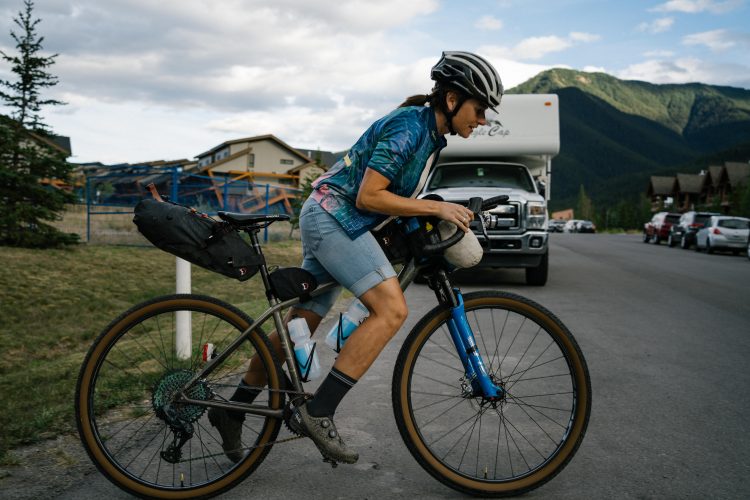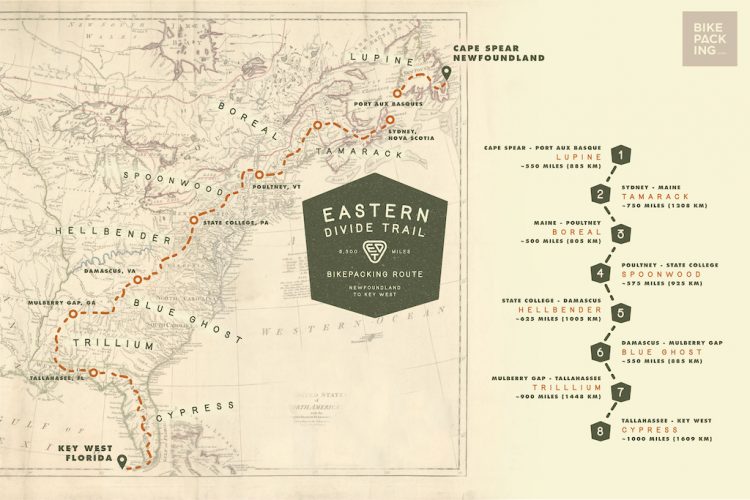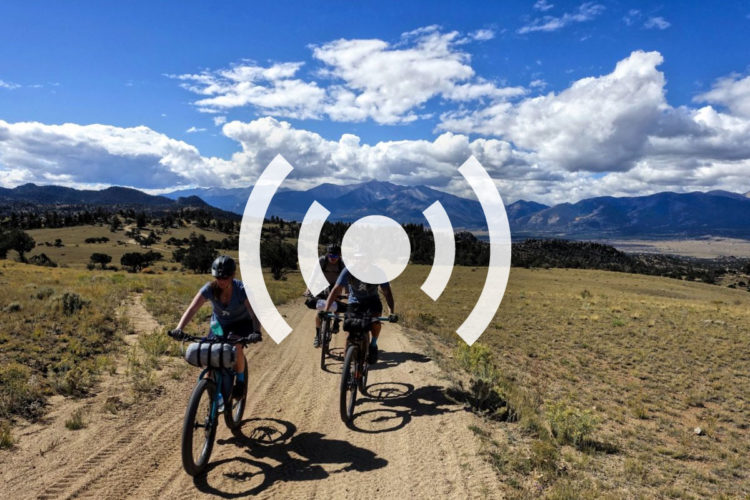
The United States has some notable cross-country bike routes that are beloved by bikepackers including the Great Divide Mountain Bike Route and the soon to be completely routed Eastern Divide Trail. These trails and routes promise to be transcendent for voyagers, both physically and psychologically.
One route that hasn’t yet garnered as much attention as the North American routes is the European Divide Trail. It’s not so much a divide in that it doesn’t follow the belly of one particular mountain range, yet it’s still a route and experience that promises just as much adventure and transcendence as any across the pond.
We reached out to Andy Cox, the founder of the European Divide Trail to find out more about the route, and what it’s like riding from Norway to Portugal or vice versa. Andy was kind enough to send some responses from the trail when he had service, and he even included a few diary entries that offer the reader a serious sense of urgency to get off the screen and get out into the woods.
Where did you find the inspiration to develop this route?

[I was] inspired by the long distance off road routes I’d seen online, mostly in the Americas. I started out on my bikepacking adventures around Europe four years ago looking for similar ones, and there weren’t any. So I decided to try to put together one that crossed the continent. Having ridden several of the more established bikepacking routes around Europe and [having] found them too physically and technically demanding for long distance, long term travel I was keen to create a route in more of a dirt road touring style, rather than an MTB style. A route that you wouldn’t necessarily need time off traveling afterwards to recover from the effort of completing it.
Was it your intent to make it the longest bikepacking route in the world?
I had never intended to make it so, but after linking together country after country I quickly realized that is was going to be huge, so that was also a reason that I felt I needed support to do such a thing, which is when I started asking companies for sponsorship to help me out. I’m not aiming for oneupmanship in creating routes, but when you cross a continent then the route tends to be a long one!
How long would it take on average to complete the route and what should someone be prepared for?
What’s in a number? Honestly, I just don’t know. Bikepacking.com wanted a number of days it would reasonably take to ride it all, so I chose 100, but it could also take you 50 or 150. Really it depends on what you’re looking to get out of the experience. Some like to travel fast and light, to cover ground quickly and spend many hours a day riding, but for others it’s about immersion in a culture or country, to eat in restaurants and visit museums. Going from within the Arctic Circle and traveling through many mountain ranges, topping out at more than 2,000m, the climatic conditions you’ll encounter will be quite extreme.
Summer in the far north only lasts about six weeks and even in mid-August there’s still snow close to sea level, whereas in the south of Europe the summer temperature can easily stay at 40°C for weeks on end and winter can be bitterly cold. It’s similar to riding from Alaska to Mexico, so you’ll need to be prepared for most weather conditions, or choose the optimum time of year and travel quickly.
What seems to be the most significant difference between the European Divide Trail and routes like the Great Divide Trail in the US or the soon to be established Eastern Divide Trail?
I would think, having not ridden either of those, it would be the nine countries the EDT crosses. The cultural and economic differences are relatively large. Obviously the languages are a big change, and the local customs. Europe is hugely diverse in its cultures and landscapes at the macro level, and on a micro scale even regional or valley to valley differences can be huge. Languages, cultural traditions, and economic prosperity changes dramatically over such distances when you cross a continent.
The “divide” sounds more symbolic on this route, rather than following an actual mountain divide. Can you speak to what these divides might mean, whether economic/social/geological/historic?
The choice of using the word “divide” for the route was certainly a nod toward the Great Divide MTB route, but also divide doesn’t only mean a watershed. From a historical point it’s about the difference from the northern nomadic Sami, to the more central Germanic/Francic, farming-based cultures, and then to the more Trans Humance culture of the south. And in the modern age, from oil-, gas-, and timber-based economies of the northerly countries, through farming, technology and industrial countries in the center, and then to more tourism and hospitality cultures in the south.
But also from some of the richest countries in the north of Europe to some of the poorest in the south. While all of the countries on the route have varying depths of recorded history, they have all been almost continually populated since the end of the last Ice Age, 10,000 years ago. While native cultures may have been assimilated over many generations, there’s still a veneration of the history they bring to the individual cultures they used to represent.
What kind of bike would you say is best for this route?

I would recommend any off-road capable bike for this route, with larger tires and a more upright riding position being more comfortable for such a long route. Gravel bikes are great for shorter trips, but the huge variety of terrain you’ll cross if you tackle the whole of this route means that a plus-tired bike with fast rolling tires is ideal. There are perhaps more paved roads than people might hope for, but then the options for off-road riding that aren’t on unsuitable hiking trails is more limited in Europe than in the Americas.
A lot more of what used to be dirt roads in Europe have been paved in the last half-century than in the USA for instance. And of course people will ride what they feel is appropriate to their comfort and skill level, but I feel that the narrower the tires you use then the more you’ll end up having to push your bike on. I tried to make the route as rideable as possible, but it all depends on your fitness and skills, gearing choice, and the amount of equipment you’ll carry. One person’s fun, smooth trail is another’s boring easy route through a forest. In my mind there’s plenty of difficult bikepacking routes to choose from but not so many where the difficulty comes from the distances traveled and the amount of time it would take to complete the whole thing, rather than the trail under your tires dictating the effort required.
What should people plan for in terms of food for this route?
While the route traverses plenty of backcountry there’s no need to carry more than 2-3 days of food even through the most sparsely populated areas. And as long as you have some sort of water purification system then you’ll not go thirsty. Cemeteries are often a good resource for fresh drinking water, and in the south there’s usually a water fountain in most towns and villages. Your smartphone is your best friend on this route for finding grocery stores and accommodation options.
Do you recommend riding south to north, or vice versa?
South to north you could start earlier in the year, perhaps early in April if you don’t mind some cold nights through the high areas of eastern Spain. There also the trails are often more rugged, looser and rockier, whereas in the north they tend to be smoother and less hard on bike and body. North to south you’d have to start later in the year, not before the end of May really, and if you were riding at more of a touring pace by the time you got into the south, then the days would be cooler and more pleasant than in the heat of summer.
What kind of wildlife do you see usually?

In the north there’s plenty of large mammals, from beavers and foxes to moose and reindeer, and if you’re really lucky perhaps even the very shy brown bears, These aren’t the grizzlies of North America, but timid animals who will run away rather than confront you. Game birds like ptarmigan, grouse, and others, plus birds of prey like golden eagles, osprey, buzzards, etc.
In central Europe there’s plenty of deer, foxes, water foul, farm animals and so on. And then into the south you might see lynx, vultures, wild goats, ibex, the iconic black cattle, Iberico pigs of Iberia, and huge flocks of sheep roaming the grasslands. Grey cranes overwinter there as do plenty of other migrating birds.
You mention in the details section on the EDT page that land laws can change. Have you or anyone else experienced this on the route and how did that affect the ride?

This is more of a disclaimer than anything specific as you never know when a trail’s usage might change or local laws could forbid bikes on a certain section. This route is the work of just one person, so while I’ve done my utmost to make sure it’s all legal to ride, at the time of publication, I can’t be responsible for making sure it all stays that way.
I’ve created a Facebook group for people to share their experiences, ask questions, and find resources that others have used, and while I’d like to help everyone in their journeys I feel I’ve done enough already by putting in three years unpaid work to make this trail in the first place, and I have other projects that I’ll spend my time on now. One of which is adding to the European Divide Trail network. I intend to double the length of it by the end of 2022, with another crossing of the continent, but from northwest to southeast this time.
Here are a few diary entries from my journal to give a taste of what is like day to day.

The Far North: (Finland)
The landscape and environment are slowly changing beneath my wheels. Gone is the Arctic tundra and I’m into the realm of river systems that drain the high country of the Swedish Norwegian border and empty into the Baltic sea. There’s enough diversity and changes in the forests and hills to keep it interesting even if some parts get a little tedious, much like the surfaces, it changes soon enough. I love these dry and partially open forests here. There’s a great feeling to them as you can see a fair way through them but they still envelop you nicely. I like the really dense ones as well; it’s the boggy overgrown type that isn’t so good. Waking up to a hard frost with its sub-zero temperatures, and it’s not even the end of August, was a bit of a shock to me. The autumn comes quickly up here in the Arctic Circle and in only a few months time this will all be under a layer of snow.
Central Europe (Germany)
A soft breeze wakes me from my slumbers. The sounds in the forest are so peaceful first thing in the morning, especially when I can’t hear traffic groaning in the distance but rather cow bells chiming and the occasional barking of a dog. I’m content to just lie in my tent and listen. The rumbling of far-off thunder fires my imagination, starts me thinking how away far it might be, whether I’ll get a soaking today, or I’ll just be able enjoy the storm clouds from a distance.
The squawk of birds, the strange barking of deer, the rustle of leaves in the wind, a church bell calling out the hour, these are the wonders of life outside. It’s been so many nights and mornings that I’ve now spent in my tent, on my own, living outdoors, I’ve grown so accustomed to it, so that when I stay inside it now feels alien. It’s stuffy with very little air movement inside, enclosed so I can’t hear and feel nature around me, I feel cut off from where I feel happy. A soft bed feels wrong. I can’t sleep properly because it’s too comfortable. I need a cool breeze, a firm floor underneath me and the quietness of my own thoughts to lull me to sleep.
My dreams are more intense while sleeping outside, but at the same time they feel more natural and because of that they’re less likely to disturb me. When sleeping outside I so rarely wake up gasping at the demons like I often do inside, suddenly awake sweating from the chase through the night away from some savage nothingness, relieved to get out of that black hole of my unconscious mind that is opened up while I sleep indoors. Outside I’m free of such terrors, my mind seems to be more open to my surroundings, free to wander and wonder, to commune with nature, to feel “a part” of this planet rather than ‘apart’ from it. My mind is free to dream, to dream of the girl with the sun in her eyes.
Through the mountains (France)
To be riding at dawn and dusk is a joy. It’s quiet, cooler, sunrise and sunset are great, the light is wonderful and soft, and of course animals are about. I was just riding along through a beautiful high altitude beech woodland, when I saw movement in the forest up ahead. Fluffy, long tail, cat shaped, except small, and then they ran up trees as I stopped and got closer. Now my mind said domestic cat, but actually I think they were wild cats, like they have in Scotland. I’ve seen footage and pictures and these Wild Kittens were just the same. Three of them mewling for their mum, and scared of the random bloke in the woods. I watched for a few moments then they were gone. I almost wet myself with excitement. Then, as I’m just reeling from seeing the coolest little fluffy things in the world, I rode around another corner and there was a full grown Lynx! The size of a large dog, tan in colour, really short tail and pointy ears. Very much different from the kittens I had just seen as they were just like a domestic cat, just kitten-sized.
The Lynx turned and ambled off into the bushes. Omfg² I’ve seen signs up at the trailheads proclaiming the wonderful animals you might see, but to see a full grown Lynx was just awesome. I remember looking at pictures of them as a child and thinking what it would be like to see one in the flesh. Words fail me to describe just how cool it was to have those encounters within 5 minutes of each other. I then saw a deer, but who cares right?
The Howling Wind takes no prisoners (Portugal)
Imagine the sound of a train coming towards you. It’s quiet at first then builds into a wall of noise until it roars past, shaking you, moving you, affecting your whole body at once, all your senses are overwhelmed by its sheer weight, size, and noise. Well that’s what this wind has been like at times. It’s been almost unbelievable how strong some of the gusts have been; the roar of it passing all around, pushing against me, even battering my very brain with its noise and force. Even now in my tent I can hear the gusts hitting the trees on the ridges above me, ripping its way through the leaves, pulsing through whole stands of trees until it tears at my tent fabric, loosening the pegs in the ground, seemingly shaking the whole world with its power. Hopefully it will stop by the morning so that I can carry on riding again.
The end’s in sight
After all the toil and struggle to get to this point, today I got my first sense that the Atlantic Ocean was not far away. After the desiccated interior of Iberia there was a feeling of humidity in the air and the expectancy of a huge body of volatile water being just over the horizon. The feeling of joy I felt this morning was also mixed with relief, to know that I’m almost finished, at least with this part of my adventures. It’s been a long time of thinking, contemplating, planning and re-riding so much of this route. The feeling of accomplishment is really special, and the best part is that I’ve been able to share this route as I’ve travelled it with the world through social media, and that social media had also brought me so many great contacts, so many people who’ve reached out to me on my adventures, who I now can call friends. I’ve so much love for this continent called Europe, and there’s still so much that I’ve not explored yet. But that’s all to save until I can start to travel again, global pandemic permitting, and continue this journey to the other ends of Europe. To be continued…
Get more information about the route at europeandividetrail.com.























0 Comments